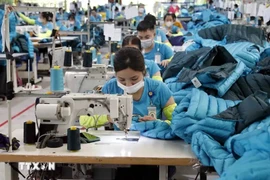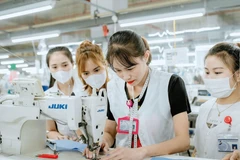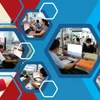Hanoi (VNS/VNA) - Vietnam needs breakthrough solutions to upgrade the value chains of the garment and footwear industries with the focus on achieving self-sufficiency in raw materials to increase added value and develop sustainably.
The local procurement rate of the footwear industry has increased significantly but there are still numerous challenges towards self-sufficiency, Nguyen Duc Thuan, Chairman of the Vietnam Leather, Footwear and Handbag Association, said.
He cited statistics that the procurement rate increased from 40% 10 years ago to currently 55%. For several products, the rate reached 70-80% for sport shoes and nearly 100% for canvas shoes.
However, the footwear industry remains largely dependent on the imports of raw materials. With competitive prices, convenient transport and diverse types and quality, China is the largest supplier of raw materials, accounting for 35% of the demand, followed by Thailand 11% and Italia 10.3%.
In the domestic market, there are 129 producers of raw materials but only 20 of them can provide high-end raw materials, he pointed out.
Thuan said it is necessary to have breakthrough solutions to upgrade the value chain sustainably.
The focus should be on promoting the development of the raw materials market in terms of scale, quality and transparency, he said, urging the formation of a raw material hub in Binh Duong province to promote the trading and innovations in the footwear and garment industry.
Both industries are mainly manufacturing on order contracts and heavily dependent of imports of materials while import markets are setting high requirements for origin traceability towards enhancing the manufacturers’ responsibility for sustainable development, Thuan said.
In addition, improving the origin transparency is essential for the industries to be able to take advantage of the tariff incentives under free trade agreements (FTAs), especially new-generation ones, urging the need for a raw material trading centre.
According to Truong Van Cam, Deputy Chairman cum general secretary of the Vietnam Textile and Apparel Association (Vinatex), for the garment industry, a material hub should be developed early so that domestic manufacturers can be self-sufficient in raw materials.
Previously, a domestic manufacturer established a raw material hub but had to close it down due to inefficiency. Early this year, Vinatex sent the proposal for the establishment of a raw material hub to the Ministry of Industry and Trade.
Cam pointed out that from international experiences, Government’s support policies are needed to ensure the success of the raw material hub, which will help domestic manufacturers to move higher in the global value chain rather than primarily relying on contract manufacturing.
The hub would also promote the development of the supporting industry for the garment and footwear industries.
Although the export turnover of the garment and footwear industries accounts for a high proportion of the country’s total trade value, the contribution of domestic enterprises remains limited, Phạm Tuan Anh, deputy director of the Ministry of Industry and Trade’s Industry Department, said.
More than 60% of garment and textile export revenue belongs to foreign direct investment (FDI) companies while the number of FDI companies makes up for just 24%. For the footwear industry, FDI companies contribute nearly 80% of the export value while account for just 30% of the total number of firms in the industry.
He said that the garment and footwear industries still focus largely on contract manufacturing and generating low-added value. The heavy dependence on imported raw materials might significantly affect the development of the industries when countries around the world are aiming for Net Zero by 2025 and setting stringent regulations about local procurement rates and origin traceability.
The development of raw materials also become essential for the industries to be able to take advantages of the FTAs, Anh said.
The development of the raw material hub is appropriate, he said, adding that the centre which will be developed from private capitals will be the place where suppliers of raw materials will gather for trading, he said.
The project on establishing the raw material hub is being finalised. The centre is expected to go operational in 2025.
Garment exports reached 32.5 billion USD in the first nine months of this year, up 9.2% over the same period last year, making the target of $44 billion export value in 2024 within reach.
Footwear exports were estimated at more than 20 billion USD in the period and expected to reach 27 billion USD for the full year if the growth rate of 10% was maintained.
Vietnam becomes the third largest footwear producers in the world, after China and India, and ranked second in footwear export./.

Garment-textile recovery on track as orders increase
The recovery of Vietnam’s garment-textile sector remains on track and is expected to make breakthroughs in the time ahead, insiders have said.



























